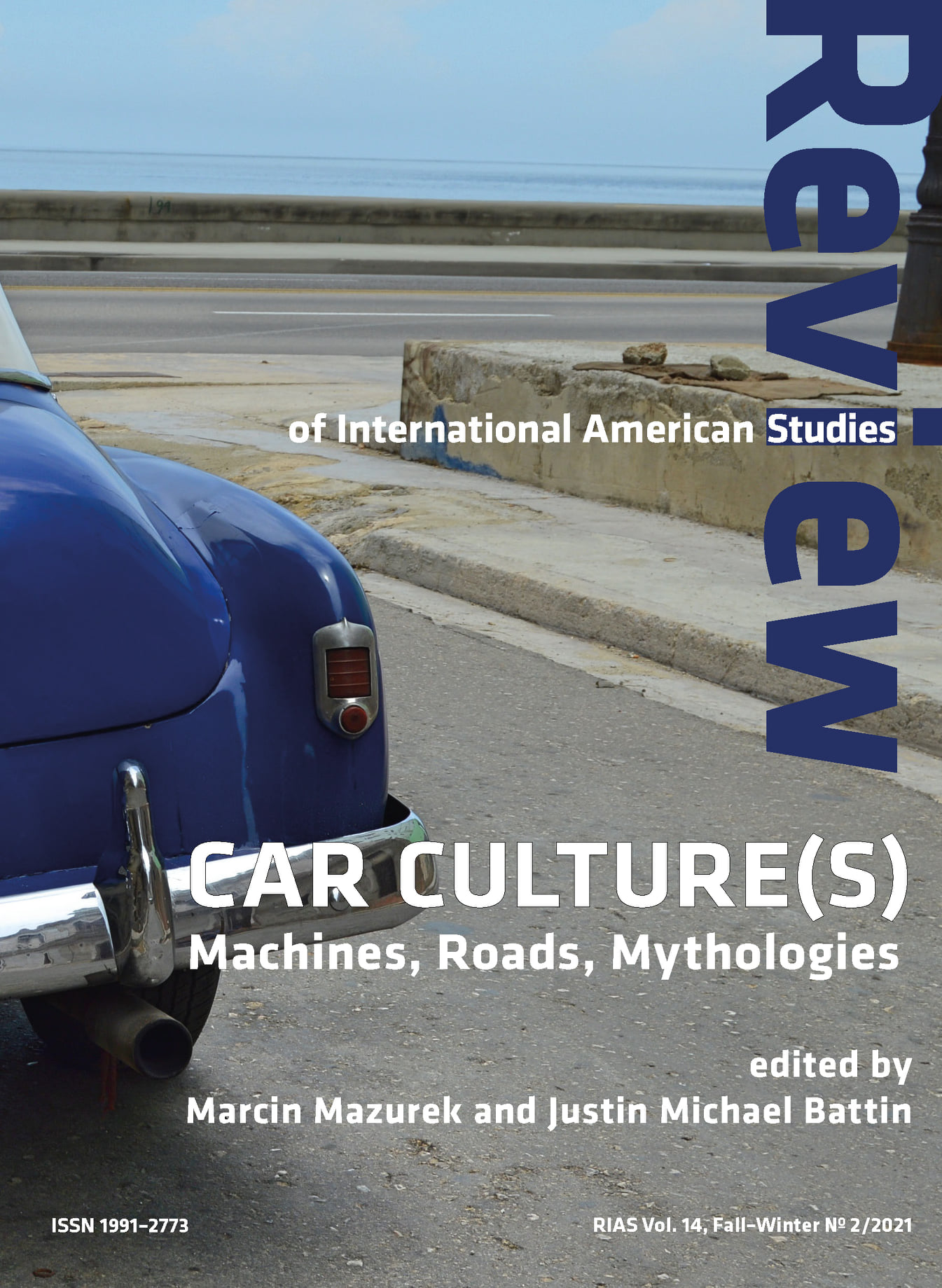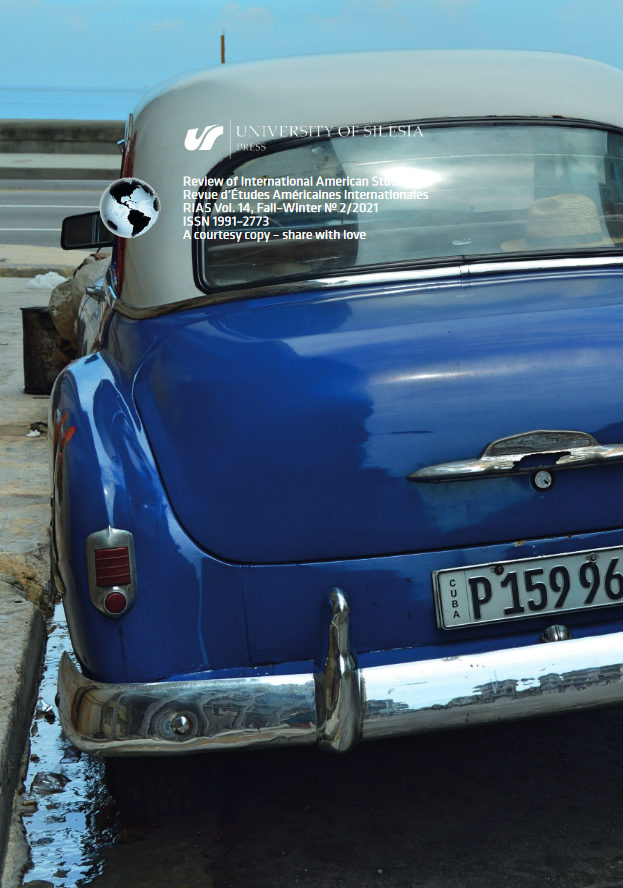Numer 14 (2/2021)
Car Culture(s): Machines, Roads, Mythologies|
Spis treści
Strony
Pobierz
|
|||||
|
Paweł Jędrzejko
(S)cars: Exploring America's Automotive Self
DOI: https://doi.org/10.31261/rias.11708
5 – 13
|
|||||
|
Słowa kluczowe Ethics |America |trauma |Europe |cars |projections |idealization |American cultural historyStreszczenie The article opens with an autoethnographic account of its author's encounter with the American sense of space in the context of the clash of his own and American cultural norms related to car ownership and car use. The initial anecdotes, in which the negative experiences of the authors lack of knowledge of the essentials of the car culture in the US prove to be instrumental in the process of learning and adaptation, lead to a more profound, historiosophic reflection upon the cars as vehicles of ethics across American cultural history. |
|||||
|
Marcin Mazurek,
Justin Michael Battin Americar Dreams (An Introduction)
DOI: https://doi.org/10.31261/rias.12822
14 – 24
|
|||||
|
Słowa kluczowe American culture |cars |Automotive cultureStreszczenie Even though Baudrillard’s catchy piece of advice as for the most effective method of exploring America’s landscapes (both real and imaginary) comes from his postmodernist travelogue limited to its titular country, it is probably difficult for anyone interested in contemporary car cultures not to extend Baudrillard’s praise of the driving experience and perceive it in cognitive rather than transportation terms, not necessarily bounded by national borders. True, American driving culture and all its related contexts—its remarkable history, its contribution to social mobility, its spectacular cars, its mythologies, the list goes on and on—is not only the oldest one historically, but—given its ties with American life-styles, politics, social stratification and the overall consumerist mindset—also the most extreme one. From Henry Ford’s Model T storming millions of American households at the beginning of the 20th century to Elon Musk’s Tesla Roadster shot into space in the second decade of the following one, cars have shaped American horizons, both private and collective, like no other machine. This introductory text presents the concept of the present issue of RIAS as well as the concepts underlying its feature texts. INFORMACJE O AUTORACH Justin Michael Battin Royal Melbourne Institute of Technology, Australia University in Ho Chi Minh City, Wietnam |
|||||
|
David Arthur Jones
America’s Automobile: Affection or Obsession, Myth or Reality?
DOI: https://doi.org/10.31261/rias.11803
25 – 55
|
|||||
|
Słowa kluczowe Automobile |wartime Nazi collaboration |muscle cars |American dream |mechanical Manifest Destiny |mobilityStreszczenie Mythology plays an important part of the role of the American automobile, less so in terms of its primary function that is transportation, more so in terms of an ancillary purpose: its metaphorical significance to both owner or operator and the onlooking public. Across much of the 20th century and continuing now into the third decade of the 21st century, the American automobile has undergone many design changes that have buttressed its metaphorical significance: become streamlined, gained then lost then partially regained size together with a colorful exterior, and in the 21st century become focused on an array of interior gadgets, some cast into hibernation because of an electronic chip scarcity resulting from trade wars and the Covid-19 pandemic. Many Americans seem to have almost become besotted by automobiles, including their own and those driven by others, because in some respects the American automobile has come to define its driver. Automobiles in the United States that are visually appealing symbolize affluence, material success, preoccupation with speed, including the rapid pace of social change, as well as, at least arguably, a lesser regard for protecting the environment. On balance, in the mindset of many Americans, the automobile is larger than life, “a mode of signification, a form” in contrast to a mere machine. Change in automotive design has been heralded as the talisman of a new generation of drivers. However, what is cause and what is effect? American automobiles conflate myth and reality; that which is together with that which might be sometime temporal frustrations with the American Dream. |
|||||
|
|
|||||
|
Słowa kluczowe popular music |popular culture |Automobile |blues |Brand Image |MercuryStreszczenie When we purchase an automobile, we are also acquiring an amorphous but very real image, that is, the statement which the automobile makes about its owner to the public. Such images are forged in popular culture, and Mercury is an automobile brand that had an auspicious post-WWII popular culture debut. In 1948, K.C. Douglas recorded “Mercury Boogie” on a 10-inch 78-RPM, with its memorable line in the chorus “I’m crazy ‘bout a Mercury.” Five years later in 1953, George and Sam Barris transformed a 1951 Mercury Club Coupe into the Hirohata Merc, creating a classic of customization that has been described as “the most famous custom of all time” (Taylor 2006: 56). Ford occasionally attempted to take advantage of these strong roots in popular culture formed in the make’s earliest days, but the company’s efforts were not notably successful. In spite of Mercury’s promising beginnings in media, it has had only a slight presence in music and film. Mercury’s image never influenced the automobile market beyond the first few years, and it was unable to prevent the brand’s 2011 demise. |
|||||
|
Ewa Wylezek-Targosz
Car Painting in America: Edward Hopper's Vision of the Road
DOI: https://doi.org/10.31261/rias.11806
75 – 88
|
|||||
|
Słowa kluczowe American Studies |modernism |Edward Hopper |paiting |car cultureStreszczenie The article presents an analysis of three paintings by one of the greatest American realist painters, Edward Hopper. The three selected works share a common denominator: they all address the concept of a car and the influence it has on the nation’s life—it has altered the way people traveled and expressed their identity. A car in Hopper’s works serves a twofold function, it allows its drivers and passengers to experience the land more as they can travel wherever they desire but, on the other hand, it contributes to a separation from their environment as the journey involves fragmentariness and rootlessness. |
|||||
|
John Eric Starnes
The Rebel Behind the Wheel: An Examination of the ‘Redneck’ Rebel Cultural Trope in The Dukes of Hazzard
DOI: https://doi.org/10.31261/rias.11815
89 – 102
|
|||||
|
Słowa kluczowe cars |television series |redneck culture |The Dukes of HazzardStreszczenie The heyday of ‘Redneck’ cinema—the 1970s to early 1980s, saw the rise of the Redneck Rebel—a Southern or otherwise ‘hick’ anti-hero who rode around the countryside like a modern-day cowboy vanquishing evil. His ‘horse’ was his car—a beefed up/souped up muscle car that often became the star of the show and overshadowed the anti-hero himself. This article examines the Redneck Rebel through the lens of one American TV series—The Dukes of Hazzard. This popular 1980s TV series, along with its antecedents and contemporaries, underscore several important points that reinforce typical conservative American virtues: freedom, fighting the ‘good fight,’ an overt heterosexuality, a particular reveling in a sarcastic ‘sticking out the tongue’ at the overly sophisticated, overly arrogant, ‘anti-American,’ and well-heeled parts of American society. |
|||||
|
L. Sasha Gora
Buddies, Lovers, and Detours: America and its Road Movies
DOI: https://doi.org/10.31261/rias.11809
103 – 119
|
|||||
|
Słowa kluczowe film |mobility |road movie |police brutalityStreszczenie Is an open road also a democratic one? Zooming in on two films—Queen & Slim (2019) and Unpregnant (2020)—this article discusses American road movie genre from the perspective of 2021, and how contemporary film narratives intersect with race and gender. One movie often drives in another film’s lane, meaning the genre is self-referential. Unfolding in three parts, the article begins by introducing these two films and surveying how they contribute to the road movie genre. It then discusses cars and clothing as characters and concludes by considering surveillance and how these films, in tandem, take the temperature of contemporary American society. |
|||||
|
James J. Ward
Existential Definition at the End of the American Road: Zabriskie Point (1970), Vanishing Point (1971), The Gauntlet (1977)
DOI: https://doi.org/10.31261/rias.11664
121 – 141
|
|||||
|
Słowa kluczowe road movie |Existentialism |anti-hero |1970s cinema |Zabriskie Point |Vanishing Point |The GauntletStreszczenie This article discusses three films that helped landmark American cinema in the 1970s. Although differing in inception and reception, all three belong loosely to the genre of the road movie and are linked by protagonists whose stances of rebellion and alienation were characteristic of the counterculture of the 1970s and by the broader theme of existential self-definition that still influences moviemaking today. A critical and commercial failure on its release in 1970, Michelangelo Antonioni’s Zabriskie Point has been revalorized as an ambitious attempt to represent the political and cultural conflicts that seemed to be fracturing American society at the time. In contrast, Richard Sarafian’s Vanishing Point soon overcame the disadvantage of studio disinterest and established itself as a cult favorite. Arguably the definitive anti-hero of 1970s cinema, the amphetamine-fueled renegade driver played by Barry Newman achieves iconic stature through an act of defiant self-destruction that still leaves viewers of the film stunned. Finally, Clint Eastwood’s The Gauntlet, in which the actor-director breaks with his ‘Dirty Harry’ persona to depict a burned-out cop who redeems a ruined career, and enables himself a new start, not by making his own law but by enforcing the law on the books, and against all odds. In all three films, the still unspoiled landscape of the American Southwest, crisscrossed by its skein of highways, provides the tableau for escapist fantasies that may in fact be real, for high-speed chases and automotive acrobatics that defy the laws of physics, and for vignettes of an ‘outsider’ way of life that was already beginning to perish. |
|||||
|
Tomasz Burzyński
Pandemic Automobility. Patterns of Crisis and Opportunity in the American Motor Culture
DOI: https://doi.org/10.31261/rias.11810
143 – 156
|
|||||
|
Słowa kluczowe trauma |automobility |COVID-19 |risk |medicalizationStreszczenie This article traces the recursive character of automobility from a perspective of cultural crises and traumas that accompany motor culture development in the USA. The American automobility system has been caught in the treadmill of ideological criticism that defined the current role of motor vehicles in forms of political activism and cultural criticism. The ongoing Covid-19 pandemic is different as it seems to bring restoration to the original character of motor culture with its defining features of individualism, freedom, and opportunity achieved through mobility. |
|||||
|
Nathaniel R. Racine
A Road Course in Early American Literature: Travel and Teaching from Aztlán to Amherst by Thomas Hallock (A Book Review)
DOI: https://doi.org/10.31261/rias.12622
157 – 164
|
|||||
|
|
|||||
|
Natalia Pająk
Nomadland: Surviving America in the Twenty-First Century by Jessica Bruder (A Book Review)
DOI: https://doi.org/10.31261/rias.12651
165 – 173
|
|||||
|
|
|||||
|
|
|||||
|
Słowa kluczowe Marietta MessmerStreszczenie A farewell to Marietta Messmer (1966–2021), the Vice President of International American Studies Association, who shaped both InterAmerican Studies and American Studies in Europe and the world. In 2009 Marietta Messmer co-founded the International Association for InterAmerican Studies, where she served as Executive Board Member and Treasurer until 2012. She was president of the Netherlands American Studies Association between 2011–2014. She was Board Member of the of the European Association of American Studies between 2009-2016, where she also served as Chair of the Organizing Committee of the conference America: Justice, Conflict, War in the Hague, April 2014. An outstanding Scholar, belowed Colleague, and fierce Friend, Marietta Messmer will be missed by all the IASA Members, whom she so mastefully led. |
|||||
|
|
|||||


